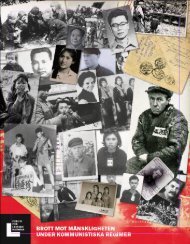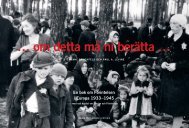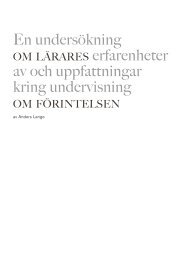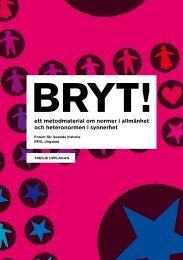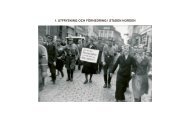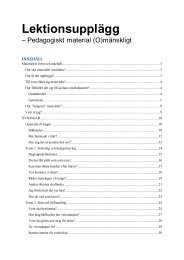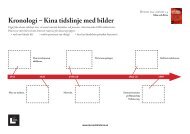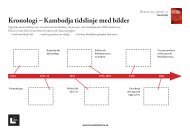Children…
Tell Ye Your Children... - Levandehistoria.se
Tell Ye Your Children... - Levandehistoria.se
- No tags were found...
You also want an ePaper? Increase the reach of your titles
YUMPU automatically turns print PDFs into web optimized ePapers that Google loves.
A poster for the 1912 Stockholm Olympic Games.<br />
It depicts the “new man”, a physical and hereditary<br />
ideal shared by many Europeans. The growing<br />
importance of sports, racism and nationalism contributed<br />
to the impact of such ideas. Similar depictions<br />
of white masculine power was characteristic of<br />
Nazi propaganda.<br />
Jews in Sweden<br />
For centuries, Sweden has hosted different minority<br />
groups. The first Jewish congregation was established<br />
in Stockholm in the 1770s, after receiving permission<br />
from King Gustav III. The rights and obligations<br />
of Jews were regulated by specific laws. Though the<br />
French Revolution of 1789 led to the beginnings of Jewish<br />
emancipation throughout Europe, Jews in Sweden<br />
were not granted full civil rights until 1870.<br />
By then, many Jews were economically and socially<br />
integrated into Swedish society, and were no longer<br />
legally discriminated against. However, antisemitic<br />
attitudes persisted, and negative portrayals of “the<br />
Jew” were commonly contrasted to all things “Swedish”.<br />
These attitudes were also propagated in literature,<br />
caricatures and film. There was also strong resistance<br />
against Jewish immigration from Central and Eastern<br />
Europe. In particular, many business men felt threatened<br />
by potential competition.<br />
“The Jewish question is<br />
not just a matter of trade<br />
and industry, it’s also a<br />
racial and cultural issue.<br />
(…) Jewry is the ruin of the<br />
European peoples.”<br />
PEHR EMANUEL LITHANDER, SWEDISH<br />
MERCHANT AND MP, 1912<br />
Racial theories in Sweden <br />
during the 1920s and the 1930s<br />
During the first half of the 20th century, concepts of<br />
“race” and the notion that individual nations had to<br />
maintain and preserve their national and ethnic “purity”<br />
were quite influential in the Western world. In Sweden,<br />
these ideas were partly implemented through<br />
the establishment in 1922 of the State Institute for<br />
Racial Biology. The Institute had broad support across<br />
the political spectrum. Research conducted under the<br />
leadership of Herman Lundborg was closely related to<br />
that of leading German “race researchers”, who enjoyed<br />
close long-term contacts and co-operation with the<br />
Swedish Institute.<br />
Notable groups in Swedish society fraternised with<br />
ideas and proposals which would later find their most<br />
radical political expression in Nazi Germany. The idea<br />
of extinguishing “life unworthy of life” was not only<br />
aired in Germany in the 1920s. In a 1922 Swedish parliamentary<br />
debate on the death penalty, leading Social<br />
Democrat and prominent journalist Arthur Engberg said<br />
that society might be forced to “consider extinguishing<br />
the lives of idiots and the physically deformed who are<br />
beyond help, and as such doomed to be a burden unto<br />
society and a curse unto others and themselves”.<br />
Interest in the possibilities offered by so-called<br />
eugenics was even greater. In 1934 and 1941, laws<br />
were passed allowing the Government to sterilise the<br />
“mentally deficient”, “vagrants”, alcoholics and “loose<br />
women”, on either social or hereditary grounds.<br />
52



